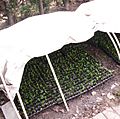Plant propagation facts for kids
Plant propagation is how we make new plants! It's like helping plants have babies. You can grow new plants from tiny seeds, or even from parts of an existing plant, like cuttings (a piece of a stem or leaf). This process can happen naturally in nature, or people can help it along.
Contents
How Plants Make More of Themselves
There are two main ways plants create new plants:
- Sexual Propagation: This uses seeds, just like how humans have babies.
- Asexual Propagation: This uses parts of a plant, like stems, leaves, or roots.
Let's explore how each one works!
Growing Plants from Seeds (Sexual Reproduction)
Sexual propagation means growing a new plant from a seed. Seeds are like small, amazing packages. They hold everything a new plant needs to start its life.
Imagine planting sunflower seeds in your garden. You put the seeds in the soil, give them water, and soon a little sunflower plant sprouts! This is sexual propagation in action.
Seeds are made when two parent plants combine their genetic material. This means the new plant might be a bit different from its parents. It could have bigger flowers, a new color, or grow taller or shorter. It's a unique mix of both parents!
Sometimes, seeds need special conditions to start growing. Some seeds need to be cold for a while, just like they would be in winter. Other seeds need smoke or even fire to "wake up" and begin growing. This is common for plants that live in areas with wildfires.
Some plants, especially large trees, don't make seeds until they are very old. This can make it tricky to grow new trees from seeds. Also, some plants don't make seeds at all, or their seeds can't grow into new plants.
Growing Plants from Plant Parts (Asexual Reproduction)
Asexual propagation is when you grow a new plant from a piece of another plant. This could be a stem, a leaf, or a root. It's like making an exact copy, or a "clone," of the parent plant. The new plant will be genetically identical to its parent.
Think about a strawberry plant. It sends out long stems called runners that grow along the ground. At the end of each runner, a new strawberry plant starts to grow. This is a perfect example of asexual propagation.
There are many cool ways to propagate plants without seeds. Here are a few common methods:
Cuttings: Snip and Grow
You can take a small piece, or "cutting," from a stem or leaf. Then, you plant it in soil or put it in water. After a while, it will grow its own roots and become a new plant.
Layering: Bend and Bury
With layering, you bend a stem of a plant down to the ground. You cover part of it with soil while it's still attached to the parent plant. Once it grows roots, you can cut it free, and you'll have a new plant.
Some plants grow in clumps. With division, you carefully separate the plant into two or more pieces. Each piece needs to have its own roots and stems. Then, you can plant each piece separately.
Grafting: Two Become One
Grafting is a special technique where you join two different plants together. The top part (called the scion) is attached to the root system of another plant (called the rootstock). They grow together as one plant. This is often used for fruit trees.
Micropropagation: Tiny Plant Factories
Micropropagation is a very advanced method. Scientists grow new plants from tiny pieces of plant tissue in a laboratory. They use special containers and nutrients to make many identical plants very quickly.
Asexual propagation is a fantastic way to make many new plants fast. It's also great for plants that don't produce seeds, or for plants that are very hard to grow from seeds.
Images for kids




